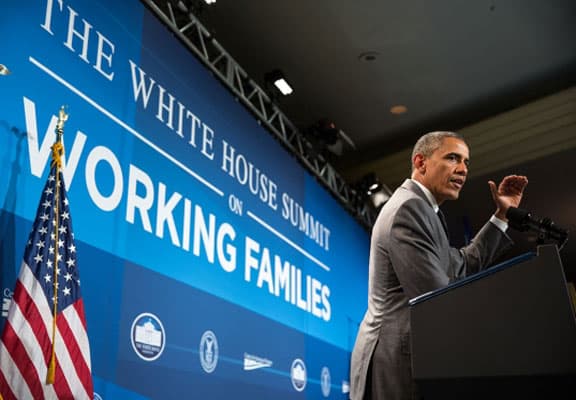

Credit: Official White House Photo by Pete Souza
(WOMENSENEWS)–The president is right. We need better family leave policies in the United States. He said so at the big White House meeting last week and it deserves repeating until we get it done.
Currently all we have in the way of guaranteed parental leave is the Family and Medical Leave Act, passed in to law during the Clinton administration and overseen by the Department of Labor.
This act provides up to 12 weeks of unpaid leave for individuals who have a new child or need to care for an immediate family member with a serious medical condition.
The Federal Employees Paid Parental Leave Act, a bill that has been bobbing around Congress since 2000, has been introduced eight times. In 2009 it passed the U.S. House of Representatives but was stopped by the Senate.
We need this law for so many reasons. For one thing, it would guarantee four weeks of paid leave to all federal employees. And that’s a biggie.
It could also usher in legislation to overcome so many inadequacies of the Family and Medical Leave Act. Bigger still!
The 1993 law was groundbreaking because it provided job protection for those who wanted to take parental leave.
But not everyone qualifies for the Family and Medical Leave Act. It is underutilized by those who do qualify because many families cannot afford to go without one parent’s income for a 12-week period. Those who can take sick pay, vacation pay and short-term disability pay to cover the income of their leave come back to work without any more available days off from work for illness or personal time until their paid time off re-ups.
Studies find that a majority of mothers prefer to care for their own infants during the first year (or have their spouse/partner care for the child) and we can see a disconnect between what U.S. policy provides and what may actually be desired by and available to many families.
Infant Care Lacking, Expensive
Part of that stay-home preference has to be tied to the lack of quality infant care and the high cost of the care that is available. Parents in the U.S. may pay anywhere from $4,850 to almost $16,400 a year for full-time infant care in a child care center, depending on the state in which they reside. And that is just for one child.
Imagine having an infant and a 3-year-old and the costs become prohibitive for many.
Meanwhile, the shortage of high-quality infant child care is acute. Recent statistics reveal that almost 6 million children under the age of 3 are cared for by someone other than their own parent(s), and more than 40 percent of those children are being cared for in settings that are poor quality. This isn’t good for anyone–not the children receiving the care or the society that they will join as adults.
Under the existing unpaid leave law, family bonding and medical emergencies are lumped together. We need to get away from that and stop treating the birth of a baby as a disability in a work environment. It’s a normal life event that employers should treat as such. In addition to extended parental leave policies, we need to think creatively about how to help corporations and families fund them.
As the White House and others hammered home at their meeting last week, the United States is a conspicuous laggard on parental leave policies. In most other industrialized countries, paid parental leave for both parents lasts from three month up to 18 months. That’s months, not weeks.
Of course these countries tax citizens at a very high rate, which means the United States may not be able to mirror approaches in places such as Canada, France, Germany and Italy, to name just a few.
However, in the United States a four-week paid leave policy based on a payroll tax is realistic. For each individual it would only cost in the range of $3,000, based on an average U.S. median weekly income of $796 during the first quarter. Even with fluctuations in pay across industries and sectors, we can afford this. For the sake of our families and our work-balance sanity, it’s a bargain.
Katherine Rose is an associate professor in early child development and education at Texas Woman’s University and a public voices fellow with The OpEd Project at TWU. She is also a mother who struggles to balance work and family.
Would you like to Comment but not sure how? Visit our help page at https://womensenews.org/help-making-comments-womens-enews-stories.
Would you like to Send Along a Link of This Story? https://womensenews.org/story/parenting/140630/4-weeks-paid-family-leave-we-can-afford

